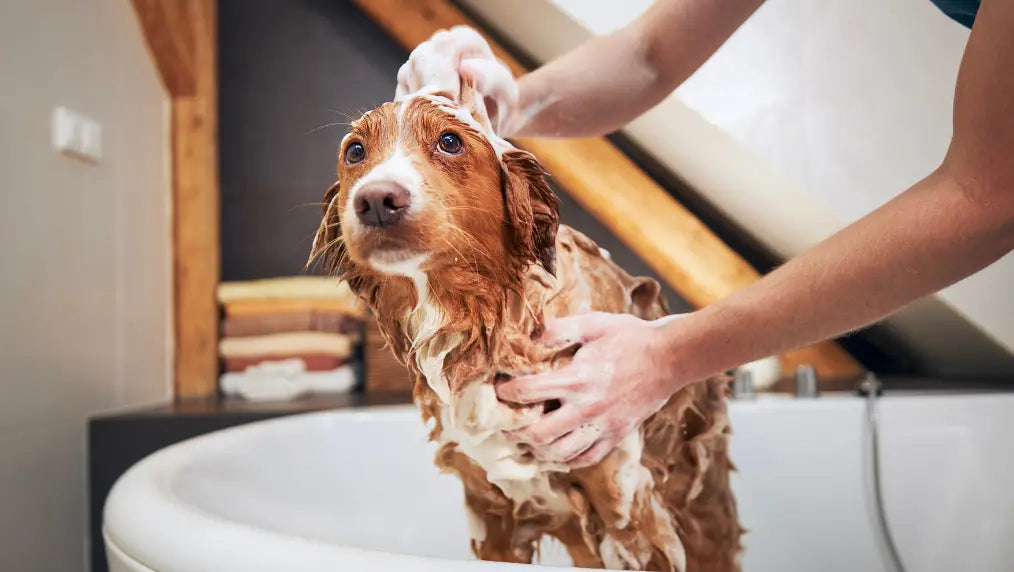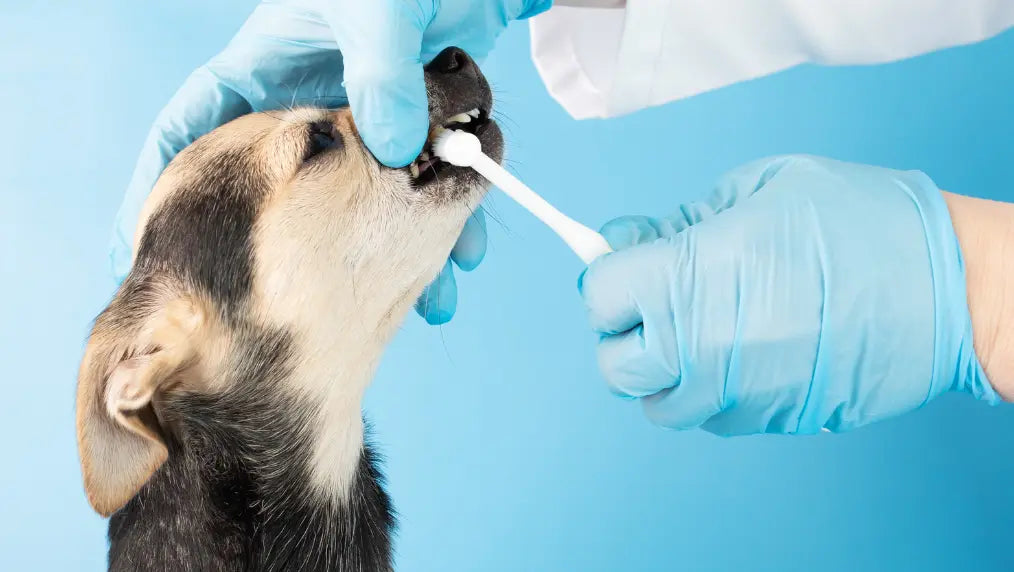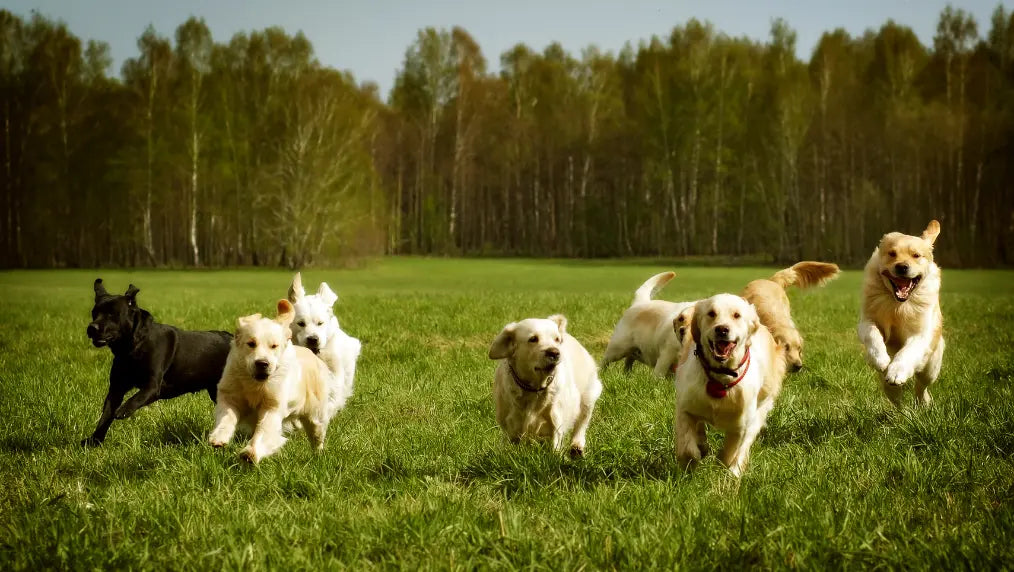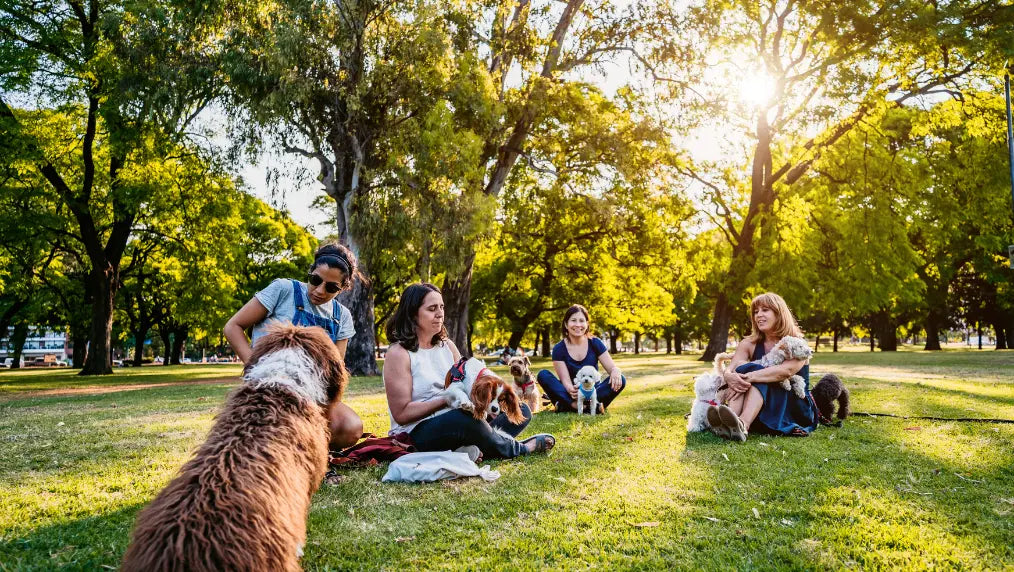Taking care of your dog's coat is a crucial part of maintaining their health and well-being. The right grooming routine and tools can promote a healthy and shiny coat while helping to prevent problems such as skin irritation, parasites, or even hair loss. A dog's coat isn't just for show either—it plays an integral role in the animal’s overall health and can indicate underlying medical issues.
Proper coat care and brushing are an essential aspect of dog ownership that often gets overlooked by many pet owners. It's completely necessary for healthy skin, to keep a dog's coat healthy, and for their overall well being. Keeping your dog's coat clean and well-maintained is crucial for their overall health and well-being. In this blog post, we will explore the many benefits of proper coat care in dogs.
Dog Hair vs. Fur

If you want to be technically correct (…and people who like being technically correct would say that’s the best kind of correct), ‘hair’ and ‘fur’ are the same things. If you looked at them under a microscope, or analyzed them chemically, you’d find no difference. Many dogs get put into one category or the other. Then what do people mean by dogs with hair versus dogs with fur? They’re usually referring to the difference between a single coat and a double coat.
A single layer of coat is sometimes called a ‘hair’ coat. It might grow long or stay short, cascade in waves or form bouncy curls, feel silky smooth or rough to the touch, but the hair all over the dog is basically the same. Other dogs have a double coat: an outer layer of thicker guard hairs and a different undercoat of thin, lightweight hairs. The undercoat is like the down on some birds that grow beneath the larger, thicker, more weatherproof feathers.
Long, Medium, and Short Coated Dogs
A dog's specific coat length can be categorized. Long coated dogs usually showcase the most dramatic coifs. Afghan Hounds, Old English Sheepdogs, and Bearded Collies have long coats that require regular grooming to keep them neat and free of mats. Owners of dogs with long coats, but who don’t show their dogs, often opt to crop the fur short into a puppy cut for ease of care. Long haired dogs require different
Short coated dog breeds are generally smooth coated. Their fur is naturally short, lays close to the body, and is often glossy. Good examples include Pointers, Doberman Pinschers, and Boxers. If your dog has a combo single/short coat, they will definitely need a dog jacket when it’s cold outside.
The fur of medium coated dogs falls in between. If they have an undercoat, the top coat may stand away from the body, giving them a slightly puffed appearance. A dog with a medium coat requires regular brushing because the feathering on his legs and tail can become matted when ignored. Dogs with medium-length coats include the German Shepherd, Golden Retriever, and Belgian Tervuren.
Brushing Prevents Matting and Tangling
One of the primary benefits of maintaining your dog's coat is preventing matting and tangling. The number one complaint that we hear from dog groomers is that pet owners do not brush their dogs, or do not brush them enough. Mats can be very uncomfortable for your dog and can even lead to skin irritation and infection. Regular brushing and grooming can help remove loose hairs and prevent mats from forming, keeping your dog's coat smooth and shiny. Depending on the dog's fur type, matting happens much easier in some breeds.
Buying the Right Dog Grooming Brushes and Tools
We always recommend investing in quality tools. Not only will they last the lifetime of your pet (if the tools are well cared for) but well-made combs and brushes will have smooth, finished teeth or tines that will glide smoothly through the coat and not cause damage as you work.
We’ve culled the best brushes and combs for different dog coat types to help you identify the most appropriate one for your pet. If you’re still not sure what to pick for your pet, talk to your breeder or groomer for tool recommendations. Breed and personality determine little. Ideally, one will choose the proper dog brush and comb for your dog’s coat type. Always gather your supplies in advance so that you won’t have to go looking for them in the middle of the grooming process. Depending on your dog’s coat, and in addition to shampoos and grooming products, you will need the following:
- Bristle Brush
- Comb
- Curry Brush or Rubber Dog Brush
- Mat and Tangle Remover
- PIN Brush
- Scissors
- Shedding Blade
- Slicker Brush
Brushing your dog regularly not only keeps their coat looking good, but it also helps release dead hair and skin follicles, helping you manage dog shedding season, remove mats, and distribute the natural oils in the skin to keep your dog healthy. Dog grooming is important for all breeds, not just those with longer hairs. Short haired dogs and shedders also require regular dog grooming and brushing.
Types of Brushes and Combs for Dogs

1. Slicker Dog Brushes
Slicker dog brushes gently work through snarls and get rid of loose and dead hairs. They usually have fine wires spaced closely together on a flat brush surface, with shorter teeth for shorter coats and medium or long teeth for medium or long coats. As many breeders’ “go to” brush, slicker dog brushes tend to work well for most breeds. They are also great at removing loose hair and being used during regular grooming.
Perfect for: Most dog breeds.
2. Dog Pin Brushes
Dog pin brushes look similar to what you might use on your own tresses. They usually have a rounded shape and wires with plastic balls on the end. A very popular choice with pet parents, they can be useful for separating, stretching and straightening the coat after a bath.
The PRIDE+GROOM ONLY BRUSH is a well-made brush that is designed to last for a long time and is suitable for a wide range of dogs in all shapes and sizes. With stainless steel pins and a solid wooden handle, your furry friend will love regular brushing. You may find that you also want to use a slicker and/or a comb in addition to this brush to pick up strands that have been shed (slicker) or to tackle mats in fur more directly (comb), but it also helps with the aforementioned issues.
Perfect for: Show dogs with curly coats (such as Poodles) or long coats (such as Lhasa Apso).
3. Dog Bristle Brushes
Short-haired dogs tend not to struggle with knots, and so usually only need a light brushing. Dog bristle brushes have tightly packed groupings of natural or nylon bristles that sweep away loose fur and distribute their hair oils. If you’re looking for a brush that gives you options, the PRIDE+GROOM double sided ONLY BRUSH is a smart choice. Use the pin side for fluff drying, and the bristle side for smoothing, shining and softening your dog’s coat. When you're trying to obtain a shiny coat or smooth coat, a bristle brush may be just what you need.
Perfect for: Smooth-coated dogs (which can also mean any dog with short hair), such as Dalmatians or Dobermans.
4. Dog Combs
Metal dog combs are first-rate for tackling unruly coats. Use a comb after brushing with a slicker dog brush. A dog grooming comb will show which areas need more brushing. Start with the wider spaced teeth, and then move to the narrower teeth, making sure you comb every part of the dog, particularly anywhere there is friction. If you find a knot, go back with the brush to get any tangles out, and then recheck with the combs.
Most combs are made of stainless steel and are perfect at removing loose hairs and matted fur during your home grooming session. Grooming sprays, like PRIDE+GROOM’s LEAVE IN conditioner, can help remove difficult tangles.
Perfect for: Dogs with medium to long coats, such as Golden Retrievers and Huskies.
5. Dog Deshedding Brushes
Do you find yourself vacuuming nonstop? Is there collected fur always in your trash bin? Give a dog deshedding brush a shot. It won’t prevent or clear away mats, but it’s effective at gathering up dead and loose hair. But be careful! A delicate touch is key, especially on your dog’s spine, shoulders and hips.
Ideal for short-hair dogs, this style brush may also be used every few days on dogs with longer coats (such as Malamutes) during shedding season, in conjunction with a good slicker dog brush and comb. Used too vigorously, it can seriously irritate the dog's skin however. This is not meant for daily brushing.
Not keen on the idea of using this kind of tool? Try bathing your shedding dog with PRIDE+GROOM’s THE SHEDDER shampoo to eliminate more shedding outside of the bath.
6. Curry Dog Brushes
Curry brushes, like THE BATH BRUSH by PRIDE+GROOM, are made of cushy rubber or plastic that loosens hair and dirt. They have bendy little nubs that are gentle enough to get right down to the dog’s skin without poking them. Curry combs are dandy on smooth-coated dogs, and work really well in the bathtub. Suds the dog up, and curry away lots of dead hair. However, they won't remove tangles on medium- to long-coated dogs.
This brush is perfect to remove dead hair on sensitive dogs. They are also great for giving your doggie a gentle massage while stimulating and releasing natural skin oil and removing loose fur.
Perfect for: Smooth-coated pups, such as Doberman Pinschers.
Dog Brush Gloves
Give your pooch a spa treatment with the right grooming glove. They typically come in many different sizes for a perfect fit! Designed with nodules on the palms, dog brush gloves provide a similar sensation to petting and can be an outstanding option for dogs who dislike being groomed. A lot of dogs would enjoy a rub down with these gloves. They will help remove some dead and shedding coats, but don’t count on them to really reduce shedding or remove tangles. In addition to ease of use, pet parents love that they allow more pressure control than with a brush.
Perfect for: Smooth- or medium-coated dogs, such as Dachshunds or German Shepherds.
Brushing Shouldn’t Replace Professional Grooming
The process of keeping your dog well-groomed should revolve around health, wellness, safety, and convenience for both you and your four-legged friend. If you don't want to deal with brushing your dog and maintaining their coat daily, a professional dog groomer can help make your life much easier! Professional grooming is also beneficial to a dog’s health in addition to their coat. Having your dog groomed can save you time and energy. It takes a lot of care and patience to groom a canine, especially a fluffy one, a puppy, or one with behavioral issues.
Brushing Helps Distribute Natural Oils
Another important benefit of proper coat care is that it helps distribute natural oils throughout your dog's coat. These oils help keep your dog's skin and coat healthy and moisturized. Regular grooming can help distribute these oils evenly, preventing dryness and irritation.
Brushing Reduces Shedding and Improves Overall Appearance
Regular grooming can also help reduce shedding in dogs. By removing loose hair from your dog's coat, you can minimize the amount of hair that ends up on your furniture and clothing. This can be especially helpful for dog owners who suffer from allergies or have asthma. Proper coat care can also improve your dog's overall appearance. A clean, well-maintained coat can make your dog look healthier and more attractive. The right kind of grooming can also help remove dirt, debris, and odors from your dog's coat, making them smell fresher and cleaner.
Bathing is Crucial
Bathing is an important part of keeping your pup's coat healthy. Regular baths can help keep their coat looking shiny and free from dirt and debris. It also helps to reduce shedding so that you don't have fur everywhere all over the house! When it comes to bathing, make sure you use a shampoo formulated specifically for dogs. Human shampoos are too harsh on their skin and can strip away natural oils that protect their coat. Additionally, by using a conditioner post-bath you can be sure to leave their coat looking and feeling softer. When it comes to choosing the right shampoo for your pup, look for one that is formulated specifically for dogs. You'll want to make sure your dog's hair is free of harsh chemicals and scents, as these can be irritating to your dog's skin and cause dryness or irritation.
High-Quality Diet
Make sure your dog is getting food of superior quality to maintain their coat quality. One tell-tale sign of low-quality dog food is that it often leaves dogs with dull, matted coats. This is because poor nutrition has a negative impact on dog coats. A healthy dog starts on the inside. Check ingredient labels or consult with a vet to make sure your dog is receiving all the nutrition they need to thrive and maintain their full and shiny coat.
Proper Coat Care Can Lead to the Early Detection of Skin Issues
Regular grooming is a great way to keep your pet's skin healthy because it can also help you detect any skin issues or abnormalities early on. By regularly inspecting your dog's skin and coat, you can quickly identify any lumps, bumps, redness, or sores that may indicate an underlying health problem. Early detection and treatment of skin issues can help prevent more serious health concerns down the road.
During a grooming session, the groomer will run their hands all over the dog’s body. If there are lumps and bumps, they will make a note of it and mention it to you. Perhaps it’s a benign growth or wart that you and your vet are already aware of, but it’s crucial to have any new lump checked out. Even if you think you give your pet a regular going-over, many owners miss areas such as under the armpits where growths may develop. It's a very crucial part of maintaining your dog's skin health.
Grooming Strengthens the Bond Between You and Your Dog
Lastly, if you are grooming your dog yourself, proper coat care can help strengthen the bond between you and your pooch. Grooming your pup regularly can be a relaxing and enjoyable bonding experience for both you and your furry friend. It can also help your dog feel more comfortable and secure, as they will come to trust and rely on you for their grooming needs.
Conclusion
In conclusion, proper coat care is essential for the health and well-being of your dog. Regular grooming and brushing can prevent matting and tangling, distribute natural oils, reduce shedding, improve your dog's appearance, detect skin issues early, and strengthen the bond between you and your pet. So, make sure to schedule regular grooming sessions for your dog to keep their coat healthy and happy. Your furry friend will thank you for it!
It's worth noting that TOO much bathing can actually hurt the quality of your dog's skin and fur from removing needed natural oils. A bath once or twice a month should be just right for your dog's cleanliness. Especially if they have sensitive skin. The general condition of your dog's skin and coat are good indicators of their health. Although health and nutrition influence the luster and texture of your pet's coat from the inside, regular grooming and skin care on the outside will help keep your dog's coat clean and free of tangles, no matter what type of hair coat they have.





